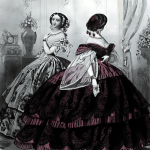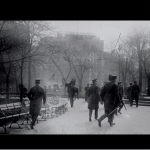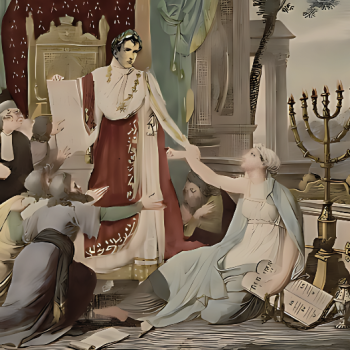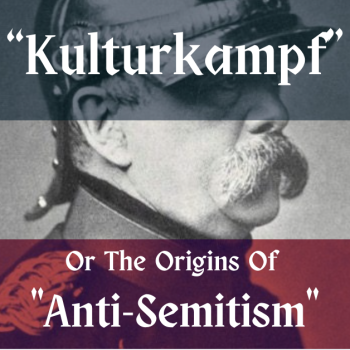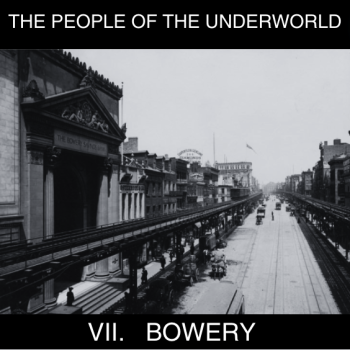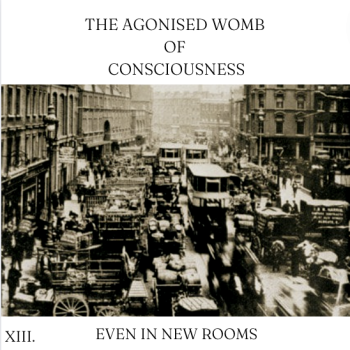In the summer of 1896, Robert Shackleton, a New York reporter, was led through a huddled gauntlet of men and women in the labyrinthine hallway of a rear tenement on Orchard Street. Shackleton continued up the shaky stairs until he entered a crowded, poorly-lit room, where a tall, “broom-bearded” man hovered over the girl like the wings of a mother hen. Singed into the flesh of the girl were the letters I.O.D.E.
“Iesus Omnium Dominus Est—Jesus is the Lord of all,” the “broom-bearded” man grimly interpreted.
The girl offered up her story. “The ‘black man’ (by which she meant the “Devil”) met me in the hallway of the settlement school,” she explained. “He seared the marks with a hot iron!”
Shackleton, not understanding Yiddish, could only guess the meaning of the animated intonations which then filled the room.[1]

A few weeks later, on June 18, 1896, School No. 4 played host to the “Devil’s” third visit in New York’s Lower East Side.
Lena Goutscher played jacks when the “Devil” approached her.
“Can I play jacks with you?” he said.
“No,” Lena replied, quite sensibly.
After a pause, the “Devil” made a face at her.
“THE DEVIL’S HERE!” Lena shouted.
“I see him!” said the other little girls, taking up the cry. “Ouch! He’s pinching me!”
The other children in the playground dropped their jackstones on the flagged ground, and raced toward the Ridge Street entrance of School No. 4. “The devil!” they shouted at the top of their lungs. “The devil!” The little girls ran past their older sisters who were drawn up in their playroom. They, too, were frightened. Now a powerful current, they produced an undertow at the entrance of the school where nearly fifty children were pulled under.
The girls spotted Emily White, the principal of the female department of the school. She brandished a long ruler in her hand.
The children rushed her.
“Mrs. White!” the sobbing throng cried out. “The devil!” “The devil!” The flood clenched Emily’s skirt. “The devil!”
“Children!” Emily shouted. “Children! Whatever is the matter?”
“THE DEVIL!”
“Nonsense!” said Emily. The confidence in her voice reassured most of the children, but Emily knew that it would only take one shout of “the devil” to break the dam.
Emily looked outside her window. Rivington Street was pandemonium. It was only a matter of time before the devil paid a visit to their school, too.
The following day, a near identical scene would play out at School No. 22. “The extraordinary ‘devil panic’ in the New York schools,” one newspaper wrote, “became a reign of terror passing all efforts of the teachers to subdue [and] suddenly turned local attention to the fact that Lucifer was a very real, and very living force in our own midst.”The origin of the “craze” remained a mystery.
“It came from somewhere and from some time,” one paper reported, “but it’s as hard to trace as bacilli or bacteria.” The paper then confessed their lateness to covering the phenomenon that had spread “like wildfire of itself.” The reporters, determined to get their scoop, interviewed the children and teachers of the schools.
“I saw the devil,” said Mamie Palsgraf. “He had big red horns on his head…and long funny feet…big, big eyes! I think they were red! His ears were pointed and his face was red all around. I could just see his tail. It was sticking out under his red jacket. In his hand he had something that looked like a fork—and he had a pipe in his mouth.”
“I watched somebody on the roof of the Rivington Street school the other night,” Jacob declared. “I don’t know who it was, but I saw a candle one minute, and the next minute it disappeared. Lots of other boys saw it. That was the same night that the girls ran out of the school. Some of the boys said that whenever they saw the light, they could see horns and a wig and feathers. I couldn’t make out any, though, but I wonder if it wasn’t some men on the roof who tried to frighten people.”
“Oh, I saw the devil!” said Sam. “He had a red face that burned like fire, and had two big horns on his head. He ran right by me in the playground and jumped up on the fence, near the stairs.” His companions shot him a look. “Then I ran away,” he added.
“Oh, I saw him, too,” said Rose. “But when I saw him he was a big tall man, with black whiskers all over his face. And when he looked at me his teeth were shining and he made faces at me. And his arms were long, and he had red tights on.”
“He..he…he…was a b-b-big man!” trembled Esther. “He d-d-dressed in black, with long d-d-dark hair…and…and…and shaggy black whiskers!” It was plain to see that whatever anyone else might believe, for little Esther, the “Devil” was a very real, and very scary being.
A reporter from William Randolph Hearst’s tabloid paper, The New York Journal, believed he had solved the mystery with an interview with Emily White, the teacher from School No. 4.
“When I think how wild with fright they were,” said Emily, “and of the terrible noise made by the crowd outside the school, I am astonished to think how fortunate we really were. Most of the children are nervous little creatures, and when one cried out in fright of the terrible devil—all took common alarm.
“The talk of the devil began among the Polish of the East Side about three weeks ago. From what I can learn many of the children heard it at home from their parents. A rabbi in an East Side synagogue announced, I am told, that the Jewish millennium was coming to kill all bad people who could not be taken into paradise. This, in my opinion, was discussed at home by ignorant and superstitious parents and more seriously discussed. The children heard it. That started the definite devil gossip among the children of the school, I think.
“Then the other day the janitor removed out of the school building, in obedience to the recent law that prohibits janitors from living in the schools. The children at once whispered to each other that the janitor left the school because the devil kept him awake at nights. That added fuel to the blaze of superstitious fear which was beginning to influence the minds of the children. They gossiped about it and shivered with fear.
“The climax of nervousness which resulted in the nearly fatal cry of ‘The Devil! There’s the Devil!’ came, I think, when some pupil in this school told a pupil on School No. 34 about the Devil gossip.
“In School No. 34 a totally different cause for superstitious dread on the part of the children existed. Three years ago an old Baptist cemetery was taken as a playground there. The bones of many buried there have not been claimed by friends. They have been stored in a vault on the premises, and the children have claimed that the playground was haunted. One of my pupils told a pupil of School No. 70 that the devil was coming. The other told of the haunted haunted playground. They compared notes, mixed their tales and got, as a result, a hair-raising story, which they thoroughly believed in themselves and told to others. It was a strange thing all around. The gathering of the pupils in the school yards where they had opportunities to discuss these horrors before school began has been stopped, but the only remedy must come through education.”[2]
Returning to the scene with the little girl in the Orchard Street tenement, Shackleton writes: “There is a strange readiness of belief that Christians, especially those of certain settlement schools, strive by spells and branding-marks to win the children of Hebrews from their faith.” The idea was preposterous to Shackleton, as with most Christians in the city, but the threat was nevertheless real, as Emily White unknowingly stated: “The Jewish millennium was coming to kill all bad people who could not be taken into paradise.” This conception was likely a reference to the “Hope of Israel,” established by Methodist missionaries in the Lower East Side. Their goal was to create a Christian congregation from Jewish converts. In 1895 the Hope of Israel’s magazine, Our Hope, added the sub-heading: “A Monthly Devoted to the Study of Prophecy and to Messianic Judaism,” thereby coining the term “Messianic Judaism.”[3]
The explanation for the burn marks on the little girl could be found in the next room. A stove-door, with the word “MODEL” engraved on it, proved to be the branding-iron. The entire word, except the “L” and the first three strokes of the “M” were burned into her arm creating the effect of “I.O.D.E.” It came to light that the girl’s little brother had pushed her into the stove, and he scared her with threats if she told on him. She remained silent about the true cause even when her mother questioned her about the marks. Her parents, at a loss for an explanation, naturally surmised the culprit from what little information they had available to them.[4][5]

SOURCES:
[1] Shackleton, Robert. The Book of New York. Penn Publishing Company. Philadelphia, Pennsylvania. (1917): 235-237.
[2] “Fear Of The Devil Starts A Panic.” The New York Journal. (New York, New York) June 19, 1896; “Wild Panic In A School.” The New York Times. (New York, New York) June 19, 1896; “Devil-Seeing In School.” The Sun. (New York, New York) June 19, 1896; “Children Saw The Devil.” The World. (New York, New York) June 19, 1896; “Thought They Saw The Devil.” The New York Times. (New York, New York) June 20, 1896; “Saw the Devil And Ran.” The World. (New York, New York) June 20, 1896; “Panics Over Satan.” The Philadelphia Inquirer. (Philadelphia, Pennsylvania) June 20, 1896; “Devil-Seeing Must Stop.” The Sun. (New York, New York) June 20, 1896; “Really Think They Saw The Devil.” The New York Journal. (New York, New York) June 28, 1896; “Children’s Visions Of The Evil One.” The World. (New York, New York) June 28, 1896.
[3] Harris-Shapiro, Carol. Messianic Judaism: A Rabbi’s Journey Through Religious Change In America. Beacon Press. Boston, Massachusetts. (1999): 27; Ariel, Yaakov. Evangelizing The Chosen People: Missions To The Jews In America, 1880–2000. University of North Carolina Press. Chapel Hill, North Carolina. (2000): 23.
[4] Shackleton, Robert. The Book of New York. Penn Publishing Company. Philadelphia, Pennsylvania. (1917): 235-237.
[5] There was evidently something “in the air” in the mid-1890s. French sociologist, Gustave Le Bon, explored this phenomena in The Crowd (1895) in which he writes: “It is not even necessary to descend so low as primitive beings to obtain an insight into the utter powerlessness of reasoning when it has to fight against sentiment. Let us merely call to mind how tenacious, for centuries long, have been religious superstitions in contradiction with the simplest logic. For nearly two thousand years the most luminous geniuses have bowed before their laws, and modern times have to be reached for their veracity to be merely contested. The Middle Ages and the Renaissance possessed many enlightened men, but not a single man who attained by reasoning to an appreciation of the childish side of his superstitions, or who promulgated even a slight doubt as to the misdeeds of the devil or the necessity of burning sorcerers.” [Le Bon, Gustave. The Crowd: A Study of the Popular Mind. The MacMillan Company. New York, New York. (1896): 130] Contrary to Emily White’s assertion that “the only remedy must come through education,” Le Bon argued that education was often so rigid, as to be just as dogmatic as church: “Foremost among the dominant ideas of the present epoch is to be found the notion that instruction is capable of considerably changing men, and has for its unfailing consequence to improve them and even to make them equal. By the mere fact of its being constantly repeated, this assertion has ended by becoming one of the most steadfast democratic dogmas. It would be as difficult now to attack it as it would have been formerly to have attacked the dogmas of the Church.” [Ibid, 102.] William James, father of American psychology, added his contribution to the discussion during his Lowell Lectures in the Autumn of 1896. According to James: “The scientific name for this disease is histro-demonopathy. It Invariably starts from some social suggestion which eventually gains complete possession over the mind of the individual, and it would be strange if these phenomena, which were so common in the past, should have died out and left nothing in their place.” [“Demoniacal Possession Merely Modern Spiritual Mediumship.” The Boston Evening Transcript. (Boston, Massachusetts) November 5, 1896.] Boris Sidis, a friend, and student of William James, elaborates on this theme in The Psychology of Suggestion, in which he writes: “In the seventeenth century the social malady of demonophobia reached its acme of development. The epidemic was in full swing. “The world seemed to be like a large madhouse for witches and devils to play their antics in.” The terror of mysterious evil agencies fell on the spirits of men. The demon of fear seemed to have obsessed the mind of European humanity. Continental Europe, especially France, Germany, and Switzerland, suffered greatly from the epidemic. High and low were attacked by this malady without any discrimination. In fact, the more learned one was the stronger was the malady, the more acute was the fear of inimical mysterious agencies. Social paranoia persecutoria seemed to have become chronic.” [Sidis, Boris. The Psychology of Suggestion. D. Appleton And Company. New York, New York. (1898): 339-340.] It would be easy for a non-believer to critique the belief in the “Devil,” as being nothing more than some ignorant superstition held by those inclined toward a religious sentiment. But then again, what is a religious sentiment? If you agree with Gustave Le Bon, then the answer is this: “A person is not religious solely when he worships a divinity, but when he puts all the resources of his mind, the complete submission of his will, and the whole-souled ardour of fanaticism at the service of a cause or an individual who becomes the goal and guide of his thoughts and actions. Intolerance and fanaticism are the necessary accompaniments of the religious sentiment. They are inevitably displayed by those who believe themselves in the possession of the secret of earthly or eternal happiness. These two characteristics are to be found in all men grouped together when they are inspired by a conviction of any kind. The Jacobins of the Reign of Terror were at bottom as religious as the Catholics of the Inquisition, and their cruel ardour proceeded from the same source.” [Le Bon, The Crowd, (1896,) 82-83.]


